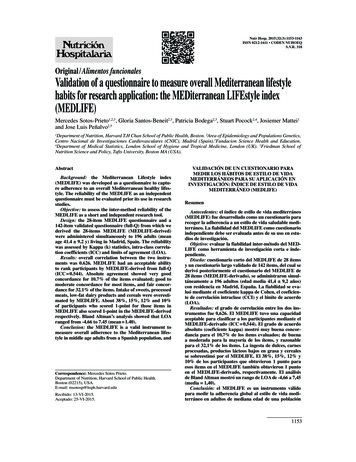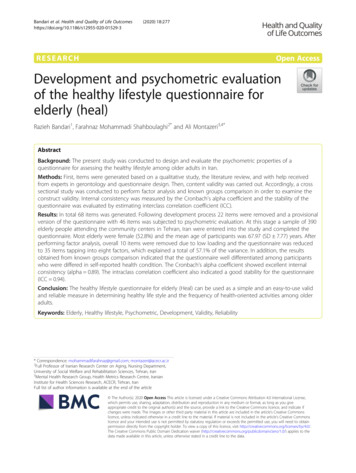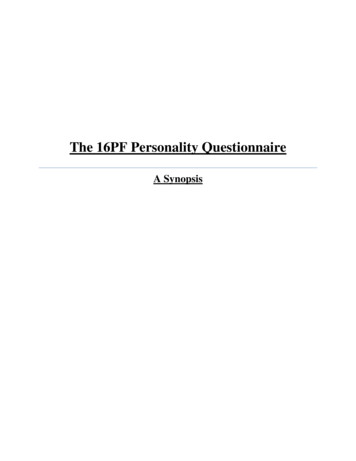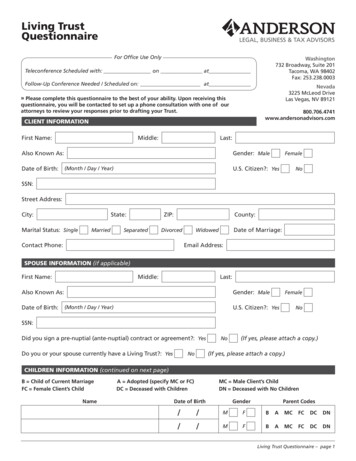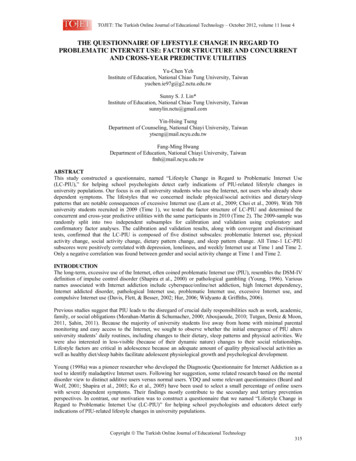
Transcription
TOJET: The Turkish Online Journal of Educational Technology – October 2012, volume 11 Issue 4THE QUESTIONNAIRE OF LIFESTYLE CHANGE IN REGARD TOPROBLEMATIC INTERNET USE: FACTOR STRUCTURE AND CONCURRENTAND CROSS-YEAR PREDICTIVE UTILITIESYu-Chen YehInstitute of Education, National Chiao Tung University, Taiwanyuchen.ie97g@g2.nctu.edu.twSunny S. J. Lin*Institute of Education, National Chiao Tung University, Taiwansunnylin.nctu@gmail.comYin-Hsing TsengDepartment of Counseling, National Chiayi University, Taiwanytseng@mail.ncyu.edu.twFang-Ming HwangDepartment of Education, National Chiayi University, Taiwanfmh@mail.ncyu.edu.twABSTRACTThis study constructed a questionnaire, named “Lifestyle Change in Regard to Problematic Internet Use(LC-PIU),” for helping school psychologists detect early indications of PIU-related lifestyle changes inuniversity populations. Our focus is on all university students who use the Internet, not users who already showdependent symptoms. The lifestyles that we concerned include physical/social activities and dietary/sleeppatterns that are notable consequences of excessive Internet use (Lam et al., 2009; Choi et al., 2009). With 708university students recruited in 2009 (Time 1), we tested the factor structure of LC-PIU and determined theconcurrent and cross-year predictive utilities with the same participants in 2010 (Time 2). The 2009-sample wasrandomly split into two independent subsamples for calibration and validation using exploratory andconfirmatory factor analyses. The calibration and validation results, along with convergent and discriminanttests, confirmed that the LC-PIU is composed of five distinct subscales: problematic Internet use, physicalactivity change, social activity change, dietary pattern change, and sleep pattern change. All Time-1 LC-PIUsubscores were positively correlated with depression, loneliness, and weekly Internet use at Time 1 and Time 2.Only a negative correlation was found between gender and social activity change at Time 1 and Time 2.INTRODUCTIONThe long-term, excessive use of the Internet, often coined problematic Internet use (PIU), resembles the DSM-IVdefinition of impulse control disorder (Shapira et al., 2000) or pathological gambling (Young, 1996). Variousnames associated with Internet addiction include cyberspace/online/net addiction, high Internet dependency,Internet addicted disorder, pathological Internet use, problematic Internet use, excessive Internet use, andcompulsive Internet use (Davis, Flett, & Besser, 2002; Hur, 2006; Widyanto & Griffiths, 2006).Previous studies suggest that PIU leads to the disregard of crucial daily responsibilities such as work, academic,family, or social obligations (Morahan-Martin & Schumacher, 2000; Aboujaoude, 2010; Tutgun, Deniz & Moon,2011, Şahin, 2011). Because the majority of university students live away from home with minimal parentalmonitoring and easy access to the Internet, we sought to observe whether the initial emergence of PIU altersuniversity students’ daily routines, including changes to their dietary, sleep patterns and physical activities. Wewere also interested in less-visible (because of their dynamic nature) changes to their social relationships.Lifestyle factors are critical in adolescence because an adequate amount of quality physical/social activities aswell as healthy diet/sleep habits facilitate adolescent physiological growth and psychological development.Young (1998a) was a pioneer researcher who developed the Diagnostic Questionnaire for Internet Addiction as atool to identify maladaptive Internet users. Following her suggestion, some related research based on the mentaldisorder view to distinct additive users versus normal users. YDQ and some relevant questionnaires (Beard andWolf, 2001; Shapira et al., 2003; Ko et al., 2005) have been used to select a small percentage of online userswith severe dependent symptoms. Their findings mostly contribute to the secondary and tertiary preventionperspectives. In contrast, our motivation was to construct a questionnaire that we named “Lifestyle Change inRegard to Problematic Internet Use (LC-PIU)” for helping school psychologists and educators detect earlyindications of PIU-related lifestyle changes in university populations.Copyright The Turkish Online Journal of Educational Technology315
TOJET: The Turkish Online Journal of Educational Technology – October 2012, volume 11 Issue 4Primary prevention regarding the promotion of health and the prevention of illness is evolving in the fields ofpublic health and psychiatry. Wallace (2002) proposed that primary prevention generally involves the preventionof diseases and conditions before their biological onset. Using concepts from the fields of epidemiology andpsychiatry, Caplan (1964) defined primary prevention as lowering of the incidence (i.e., rate of new cases) of aspecified mental disorder; the aim of primary prevention is to reduce incidences of a problem or disorder beforeit forms. Accordingly, our focus is on all university students who use the Internet, not users who already showsevere dependent symptoms. The PIU is a cause for great concern in Taiwan, a country with more than 1.3university students comprising 5.8% of the total population (Ministry of Education, 2011). We believe that asignificant percentage of these students are facing challenges in terms of managing their Internet usage at somepoint during their college careers.In this paper we describe how we tested for a conceptually meaningful factor structure using both exploratoryfactor analysis (EFA) and confirmatory factor analysis (CFA). The EFA was applied to a calibration sample, andthe CFA was tested using a validation sample. We also examined the concurrent and predictive cross-yearutilities of the LC-PIU on depression and loneliness as well as the relationships among LC-PIU scores, genderand weekly Internet use. In addition, the internal consistency reliability of the total scale and each subscale weretested.Research of Problematic Internet Use and measurementsBecause Internet addiction is not yet recognized in the Diagnostic and Statistical Manual of Mental Disorders,Fourth Edition, Text Revised (DSM-IV-TR; American Psychiatric Association, 1994) most research in this areahas adapted the diagnostic criteria of pathological gambling. Recently, some experts have supported theinclusion of Internet addiction in the upcoming DSM-V. For example, Block (2008) proposed including the term“Internet addiction” in the DSM-V as a diagnosis of compulsive-impulsive spectrum disorder that involvesonline, offline, or both types of computer use. He also believes that at least three subtypes should be included:excessive game playing, sexual preoccupation, and e-mail/text messaging. All three are marked by excessiveusage, withdrawal, tolerance, and negative repercussions.Many different diagnostic criteria have been suggested for the identification of Internet addiction. Firstintroduced by Goldberg (1995) and made popular in subsequent empirical research, Young (1996) adopted theDSM-IV criteria for substance dependence to describe the impairment of an individual with “Internet addiction.”Later, Young (1998a) adopted the DSM-IV criteria of pathological gambling, an impulse-control disorder, intoher Diagnostic Questionnaire. DQ consists of 8 items. If a participant answers “yes” to more than 5 of the 8criteria, then the participant is classified as Internet dependent. Young (1998b) also created the 20-item InternetAddiction Test (IAT) with six factors: salience, excessive use, anticipation, lack of control, neglect of work, andneglect of social life. Likewise, Brenner (1997) generated the Internet-Related Addictive Behavior Inventory(IRABI) that uses 32 true-false questions. He extracted three factors from the IRABI: tolerance, withdrawal, andcraving. Moreover, Morahan-Martin and Schumacher (2000) developed 13 yes-no questions to assess theproblems due to Internet use by adapting Young’s Internet addiction criteria.Young (1996) proposed the first set of “Internet addiction” diagnostic criteria by adopting the substancedependence criteria from the DSM-IV due to similarities she observed with regard to the states of tolerance andwithdrawal. Subsequently, Young (1998a) updated her diagnostic questionnaire using the DSM-IV definition ofpathological gambling, an impulse control disorder often described as a behavioral addiction. However, manystudies admitted that the term “Internet addiction” is confusing and lacks scientific evidence. For example,Murali and George (2007) suggest that the nosological and conceptual ambiguity surrounding Internet addictionhas led many researchers to question its untested validity. These opponents propose that the term “Internetaddiction” be replaced by those such as excessive, maladaptive or problematic Internet use. Some researchersavoid using the term “Internet addiction”, while others criticize its definition as being too narrow to capture thepopulation of problematic Internet users. This limitation leads to premature conclusions regarding a new disorderand the patients who have related symptoms (Aboujaoude, 2010). Specifically, Beard and Wolf (2001) as well asShapira, Lessig, Goldsmith, Szabo, Lazoritz, Gold, and Stein (2003) have suggested using the less controversialterm “problematic Internet use” rather than “Internet addiction.” Shapira, Goldsmith, Keck, Khosla, andMcElroy (2000) stated that problematic Internet use is characterized by an individual’s inability to control theirurge to use the Internet without concern for the consequences. This lack of will power results in feelings ofdistress and the functional impairment of daily activities. Shapira et al. (2003) conceptualized problematicInternet use as an impulse control disorder. An individual should be diagnosed with problematic Internet use ifhe or she exhibits three phenomena (a) maladaptive preoccupation with Internet use, such as experiencing anirresistible use of the Internet and using the Internet more than the amount of time intended; (b) clinicallysignificant distress or maladaptive functioning in social, occupational, and other critical areas due to excessiveCopyright The Turkish Online Journal of Educational Technology316
TOJET: The Turkish Online Journal of Educational Technology – October 2012, volume 11 Issue 4Internet use; and (c) overuse of the Internet that does not occur during a phase of mania or hypomania and is nototherwise explained by an Axis-I disorder.Similarly, Caplan (2002) constructed the Generalized Problematic Internet Use Scale (GPIUS), which includedseven factors: mood alteration, perceived online social benefits, negative outcomes associated with Internet use,compulsive Internet use, an excessive amount of time spent online, withdrawal symptoms and perceived onlinesocial control. Moreover, Demetrovics, Szeredi, and Rozsa (2008) modified Young’s (1998b) Internet AddictionTest and added additional questions to create the Problematic Internet Use Questionnaire. This questionnairemeasures the problems associated with Internet use, which resulted in a three-factor model that includedobsession, neglect, and control disorder. The obsession subscale was defined as mental engagement with theInternet as well as the anxiety, worry, and depression caused by a lack of Internet use. Items about the decreasingtypical activities (e.g., work, studies, and partner relations) because of an increased amount of Internet use werenamed as neglect scale. The control disorder subscale measured the inability to decrease the amount of timespent on the Internet and self-perceptions of Internet use as problematic. The current study adopted the term“problematic Internet use” to describe the core maladaptive behaviors related to excessive Internet use.The Lifestyle-Related Factors of Problematic Internet UseClassical sociological theorists originally viewed the concept of lifestyle as a component of stratificationsystems. For example, Weber emphasized lifestyle as a means for social differentiation. Lifestyle is composed oftwo basic elements including structured conditions (or “life chances”) and personal choice (or “life conduct”)(Backett & Davison, 1995). Lifestyle denotes the relationship between an individual and a particular group inwhich the individual has a sense of belonging to the group due to his or her choice and some suggestions ofstructured life changes (Abel & McQueen, 1991).The concept of lifestyle then has been refined and is comparable to the biomedical risk factor and thepsychological approaches of major health behavioral research. Lifestyle became a central concept in thedevelopment in health promotion theory and practice. Lifestyle provides the loosely defined link between theepidemiologically designated health-risk factors at the individual level (e.g., diet, drinking, exercise level andsmoking) and the preventive medicine or health promotions at the population level. In addition, Coulson, Eiser,and Eiser (1997) proposed that the focus of lifestyle includes both the presence of health-damaging andhealth-enhancing behaviors. Lifestyle can be seen as the distinctive mode of living defined by a set of expressiveand patterned behaviors of individuals occurring with some consistency over a period of time.Ha, Kim, Bae, Bae, Kim, Sim, Lyoo, and Cho (2007) mentioned that adolescents are more at risk for problematicInternet use than adults, and the former group’s lifestyle habits are easily affected by the excessive use of theInternet. Some research indicates that adolescents who develop problematic Internet use might have adverseconsequences and changes in several lifestyle-related factors including physical inactivity, extended time spenton the Internet, increased use of alcohol and tobacco, short durations/lack of sleep, and irregular dietaryhabits/poor eating patterns (Gunnell et al., 1998; Lam et al., 2009; Kim & Chun, 2005; Choi et al., 2009).The present study constructed a new questionnaire to include lifestyle-related factors of problematic Internet use(physical activities, social activities, dietary and sleep patterns). The validation procedure is the focus of thispaper. Our specific research questions are:1. Does the exploratory factor analysis of the calibration sample demonstrate a conceptually meaningfulfactor structure?2. Based on the factor structure of the calibration sample, does the factor structure of the validation samplefit the data using a confirmatory factory analysis?3. Are the alpha reliability coefficients of the LC-PIU factors acceptable?4. Do the correlations among the LC-PIU scores, depression, loneliness, weekly Internet use and gendersupport the concurrent and cross-year predictive validity of this measure in 2009 (Time 1) and 2010 (Time 2)?Copyright The Turkish Online Journal of Educational Technology317
TOJET: The Turkish Online Journal of Educational Technology – October 2012, volume 11 Issue 4METHODParticipantsParticipants were drawn from the respondents of a national panel survey funded by the National ScienceCouncil, Republic of China which aimed at collecting adolescent Internet use and physical-mental developmentdata. The sample consisted of 708 freshmen (360 male, 348 female) enrolled in Time 1. We randomly dividedthe sample (n 708) at Time 1 into two independent groups for the purpose of validity examinations. One yearlater, we collected data regarding depression, loneliness, and weekly Internet use of the same participants. Therewere 540 participants at Time 2 to allow for missing data in the panel study.MeasuresWeekly Internet use. Participants were asked to estimate their average weekly use of the Internet on aseven-point scale ranged from “one day” to “every day.” Next, participants estimated how much time they spenton the Internet on a thirteen-point scale ranged from “less than one hour” to “more than twelve hours.” Mostrespondents (59.75%) used the Internet 7 days a week (male, 63.89%; female, 55.46%). The majority (48.30%)of the participants spent 2 to 4 hours on the Internet each day (male, 46.39%; female, 50.29%). A compositeamount of weekly Internet use was calculated by multiplying the frequency of a week by the daily time. Higherscores indicate that participants Internet use longer.Questionnaire of Lifestyle Change in Regard to Problematic Internet Use (LC-PIU). The LC-PIU partiallyconsisted of items concerning preoccupation with/irresistible Internet use, tolerance and withdrawal selectedfrom Lin and Tsai’s (1999) Internet Addiction Scale for Taiwanese high school students (IAST). Examples fromthe LC-PIU include “Though I plan to use the internet for just a while, I stay online longer than originallyintended” and “When I try to cut down or stop my Internet use, I feel anxious.”Additional items were constructed by considering different lifestyle changes described in the problematicInternet use literature. Participants must estimate how much a given statement describes the influence of Internetuse on the changes of lifestyle on a 5-point scale. Examples of the physical activity change items include “Ineglect exercise due to spending time online” and “I remain seated longer than two hours when I am online.”Examples of the social activity change items are “I reduce face-to-face contact with others because of theInternet” and “I would rather spend time online than attend activities with friends and family.” The dietarypattern change items state “I spend time online such that I ignore regular meals and eat whatever is available”and “While using the Internet I forget to drink water for a long time.” Lastly, the sleep pattern change itemsinclude “I have reversed sleep patterns because of the Internet” and “I would rather spend time online than go tobed at night.” The LC-PIU has 23 items in total.Beck Depression Inventory (BDI). The Beck Depression Inventory (BDI; Beck, Rush, Shaw, & Emery, 1979) isa 21-item, self-report measure of depression severity. Each of the 21 items is rated on a 4-point scale. The ratingsare summed and yield a total score that ranges from 0 to 63.Chinese Version of the Loneliness Scale (LS). Lin and Lin (2007) revised the Loneliness Scale (De JongGierveld & Kamphuis, 1985) into Chinese. This scale is composed of two subscales: “emotional loneliness” and“social loneliness.” The former includes six negatively worded items related to aspects of exclusion. An exampleitem states, “I often feel rejected.” The latter subscale includes five positively worded items related to feelings ofbelonging. An example statement includes “There are plenty people who I can rely on when I have problems.”Each of these 11 items is rated on a 2-point scale. The total score ranges from 0 to 11. In the present study, theCronbach’s alpha reliability was 0.76 for the total scale.Statistical analysesStatistical analyses were conducted in several stages using SPSS 13.0 and LISREL 8.80. The data wererandomly divided into two independent subsets for the purpose of examining validity. First, an exploratory factoranalysis (EFA) using principal axis factoring with promax rotation was adopted for Subsample 1. Factors wereidentified as those with eigenvalues greater than 1.00. A value of 0.30 was used as a viable cutoff for judging thesaliency of factor loadings. Second, we tested the validity of the factor structure derived from the results of theEFA with Subsample 1 using confirmatory factor analysis (CFA) on Subsample 2 within the framework ofstructural equation modeling.In CFA, several criteria are used to determine the overall fit between the data and the hypothesized structure.These include the Comparative Fit Index (CFI), which must meet or exceed 0.90 (Bentler & Bonett, 1980); theRoot Mean Square Error of Approximation (RMSEA) in which values less than 0.05 are indicative of good fitand those between 0.05 and 0.08 are indicative of a reasonable fit (Browne & Cudeck, 1993); and the StandardRoot Mean Square Residual (SRMR) in which values less than 0.08 indicate acceptable fit (Hu & Bentler, 1999).Copyright The Turkish Online Journal of Educational Technology318
TOJET: The Turkish Online Journal of Educational Technology – October 2012, volume 11 Issue 4RESULTSExploratory Factor AnalysisTo generate the factor structure of LC-PIU, a principal axis factoring with promax rotation was conducted for the23 items in Subsample 1 (calibration sample, n 354) selected from the random split-half of the whole Time 1sample. This analysis resulted in a five-factor solution that explained 59.75% of the total variance. The firstfactor included 5 items regarding preoccupation with Internet use, tolerance and withdrawal; thus, this scale waslabeled “problematic Internet use.” The second factor, the “physical activity change scale,” included 5 items thatdescribed reductions to participants’ exercise schedules due to Internet use. The third factor included 5 itemsabout the reduction in the frequency/quality of participants’ interpersonal relationships including offline friends,family members, and relatives; thus, this factor was labeled the “social activity change scale.” The fourth factor,the “dietary pattern change scale,” included 5 items related to decreases in maintaining a regular diet due toInternet use. The fifth factor, “sleep pattern change scale,” included 3 items about delaying sleep or changingsleep patterns due to Internet use.Confirmatory Factor AnalysisBased on time-1 Subsample 2 (validation sample, n 354), we conducted a CFA to retest the LC-PIU’sfive-factor structure derived from the EFA calibration of time-1 Subsample 1. The results revealed a model thatobtained an adequate fit to the data (χ2(220, N 354) 317.16, p .01; CFI 0.97; RMSEA 0.050; SRMR 0.061).Anderson and Gerbing (1988) suggest that examining the convergent and discriminate validities are twoapproaches to further assess fit. Convergent validity is evaluated on the measurement model by determiningwhether the estimated coefficient of each indicator on its accordingly underlying latent factor is significant. Thestandardized coefficients shown in Figure 1 are all statistically significant. The factor loadings of problematicInternet use, physical activity change, social activity change, dietary pattern change, and sleep pattern changeranged from 0.60 to 0.78, 0.54 to 0.73, 0.39 to 0.81, 0.42 to 0.63, and 0.71 to 0.73, respectively. These resultsreveal that these five factors have an adequate convergent validity.To examine the discriminant validity among the five factors, we adopted Anderson and Gerbing’s (1988)approach in which the correlation between any two latent factors was constrained to 1.0, allowing a researcher toperform a chi-square difference test on the values obtained for both constrained and free-estimate models. Thechi-square differences of the constrained and free estimated models were χ2 69.59 (df 1, p .001) forproblematic Internet use and physical activity change, χ2 101.75 (df 1, p .001) for problematic Internet useand social activity change, χ2 34.2 (df 1, p .001) for problematic Internet use and dietary pattern change, χ2 45.49 (df 1, p .001) for problematic Internet use and sleep pattern change, χ2 93.66 (df 1, p .001) forphysical activity change and social activity change, χ2 39.92 (df 1, p .001) for physical activity change anddietary pattern change, χ2 31.8 (df 1, p .001) for physical activity change and sleep pattern change, χ2 72.51 (df 1, p .001) for social activity change and dietary pattern change, χ2 107.33 (df 1, p .001) forsocial activity change and sleep pattern change, and χ2 45.17 (df 1, p .001) for dietary pattern change andsleep pattern change. These results indicated that adequate discriminant validities were shown among the fivefactors. The alpha reliability coefficients for these factors were acceptable ranging from 0.75 to 0.83.Copyright The Turkish Online Journal of Educational Technology319
TOJET: The Turkish Online Journal of Educational Technology – October 2012, volume 11 Issue 4χ2(220, N 354) 317.16 (p .01), CFI 0.97, RMSEA 0.050, SRMR 0.061Figure 1. The five-factor model of the LC-PIUCopyright The Turkish Online Journal of Educational Technology320
TOJET: The Turkish Online Journal of Educational Technology – October 2012, volume 11 Issue 4The association between the LC-PIU and validation measures: Concurrent and cross-year predictive utilitiesPearson correlation was adopted to assess the concurrent validity of LC-PIU. The correlation coefficientsbetween “problematic Internet use”, “physical activity change”, “social activity change”, “dietary patternchange”, and “sleep pattern change” at Time 1 and Time-1 depression were 0.33, 0.28, 0.27, 0.30, and 0.26 (ps .01), respectively; the correlations between LC-PIU subscales at Time 1 and Time-1 loneliness were 0.20, 0.21,0.29, 0.18, and 0.17 (ps .01), respectively. As also shown in Table 1, participants’ Time-1 weekly Internet usewas significantly correlated with problematic Internet use (r 0.31, p .01), physical activity change (r 0.44,p .01), social activity change (r 0.22, p .01), dietary pattern change (r 0.28, p .01), and sleep pattern change(r 0.29, p .01) at Time 1. The longer the participants spent on the Internet per week, the more severe theirproblematic Internet use and unhealthier lifestyle changes.Similarly, problematic Internet use, physical activity change, social activity change, dietary pattern change, andsleep pattern change at Time 1 were positively correlated with Time-2 depression (0.21, 0.27, 0.19, 0.23, and0.22, respectively, ps .01) and Time-2 loneliness (0.13, 0.18, 0.19, 0.13, ps .01, and 0.10, p .05) that showcross-year predictive utility of the LC-PIU questionnaire. In addition, the LC-PIU of Time 1 were positivelycorrelated with weekly Internet use (0.21, 0.38, 0.15, 0.21, and 0.23, respectively, ps .01) of Time 2, cross year.Gender was not significantly correlated with most of the LC-PIU subscales at either Time 1 or Time 2, althoughthere was a negative correlation between gender and social activity change (r -0.12, p .01 and r -0.09, p .05at Times 1 and 2, respectively). Men were less active on social activity due to Internet use compared withwomen.Table 1. The inter-correlations among the study variables at Time 1 (n 708) and Time 2 (n 540)PIU, T1PAC, T1SAC, T1DPC, T1SPC, PIU, T1---PAC, T1.62**SAC, T1.55**.60**DPC, T1.56**.57**.48**SPC, T1.57**.57**.48**.54**Depression, T1.33**.28**.27**.30**.26**Loneliness, T1.20**.21**.29**.18**.17**WIU, T1.31**.44**.22**.28**.29**.01.06Depression, T2.21**.27**.19**.23**.22**Loneliness, T2.13**.18**.19**.13**.10*WIU, T2.21**.38**.15**.21**.23**Gender, T1a------.12**----.01----.03aGender, T2.04.06-.09*.02.00* p .05, ** p .01Note. T1 time 1; T2 time 2; PIU problematic Internet use; PAC physical activitychange; SAC social activity change; DPC diet pattern change; SPC sleep pattern change;WIU weekly Internet use.a1 male, 2 femaleCopyright The Turkish Online Journal of Educational Technology321
TOJET: The Turkish Online Journal of Educational Technology – October 2012, volume 11 Issue 4DISCUSSIONUsing a sample of Taiwanese freshmen, we confirmed that the LC-PIU, a newly developed screening tool forprimary prevention, has a meaningful and distinct factor structure. We randomly divided the sample (n 708) atTime 1 into two independent groups for the purpose of validity examinations. In Subsample 1, an EFA of theLC-PIU items resulted in a five factors: problematic Internet use, physical activity change, social activitychange, dietary pattern change, and sleep pattern change. The CFA on Subsample 2 revealed an adequate-fittingmeasurement model confirming the five latent constructs extracted from EFA on Subsample 1. Two-step factorstructural examinations showed a strong support to the construct validity to LC-PIU questionnaire. Thereliability (alphas coefficients) for these five factors were acceptable. The results also revealed an adequateconvergent and discriminant validity among these five factors.A concurrent, cross-year predictive utility examination revealed positive correlations between LC-PIU scoresand depression as well as between LC-PIU scores and loneliness at Times 1 and 2. Our result is consistent withprevious findings that longer Internet use is associated with higher depression and loneliness in universitystudents. For example, Fortson, Scotti, Chen, Malone, and Del Ben (2007) found that abuse of and dependenceon the Internet was associated with depression among undergraduates. Lin, Ko, and Wu (2011) found Internetaddiction was positively correlated with a greater number of depressive symptoms in Taiwanese collegestudents. Koç (2011) found the addicted Turkey university students were more depressed than the non-addicted.A. Ceyhan and E. Ceyhan (2008) indicated that loneliness and depression significantly predicted problematicInternet use; loneliness was found to be the most important predictor of problematic Internet use, and depressionwas the second most predictor among university students. Morahan-Martin and Schumaker (2000) found thatloneliness was associated with pathological Internet use in undergraduate students.In addition, our results indicate that gender was not significantly correlated with problematic Internet use,physical activity change, dietary pattern change, or sleep pattern change but was correlated with social activitychange. Specifically, male freshmen reported less active social activity due to Internet use compared withfemales. Previously, Kraut, Patterson, Lundmark, Kiesler, Mukopadhyay, and Scherlis (1998) found that heavyInternet use was associated with longitudinal declines in the size of adolescents’ social circle, social contact, andfamily communication. Nie, Hillygus,
This study constructed a questionnaire, named "Lifestyle Change in Regard to Problematic Internet Use (LC-PIU)," for helping school psychologists detect early indications of PIU-related lifestyle changes in university populations. Our focus is on all university students who use the Internet, not users who already show dependent symptoms.


